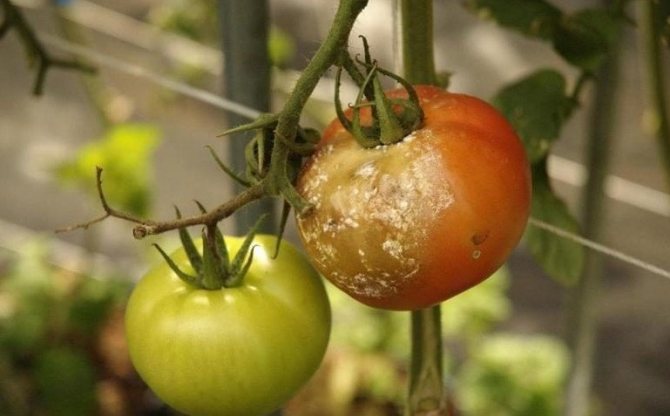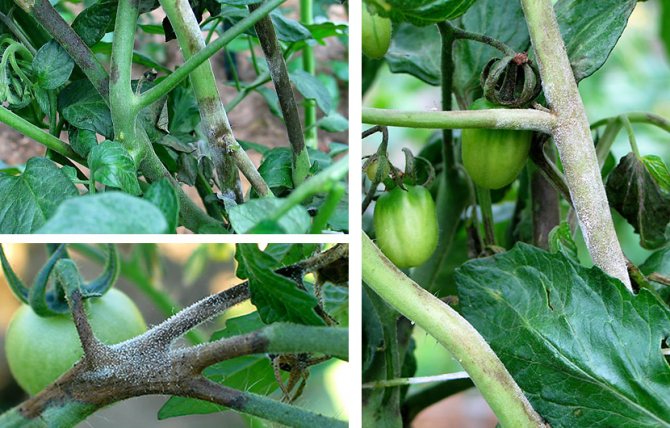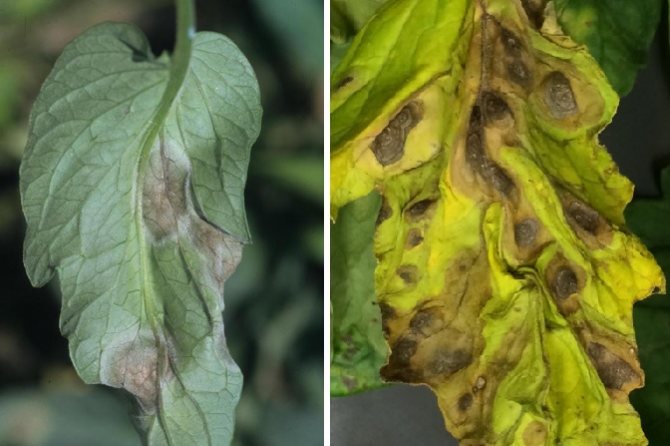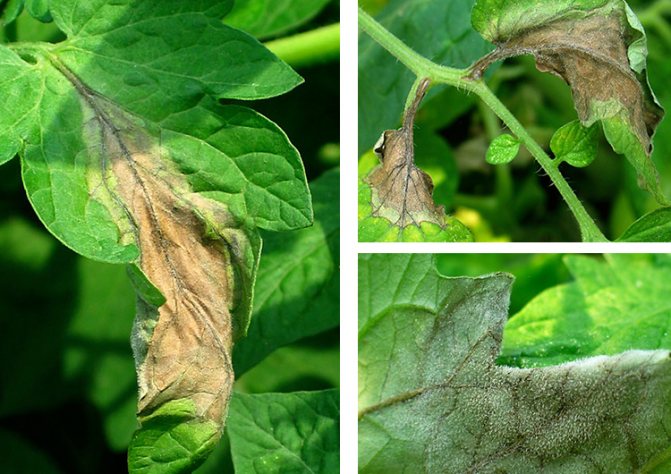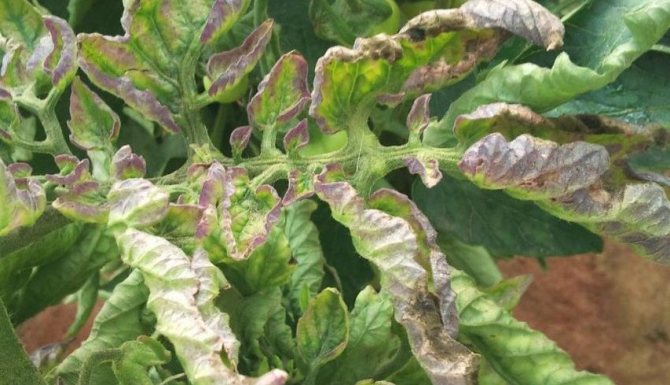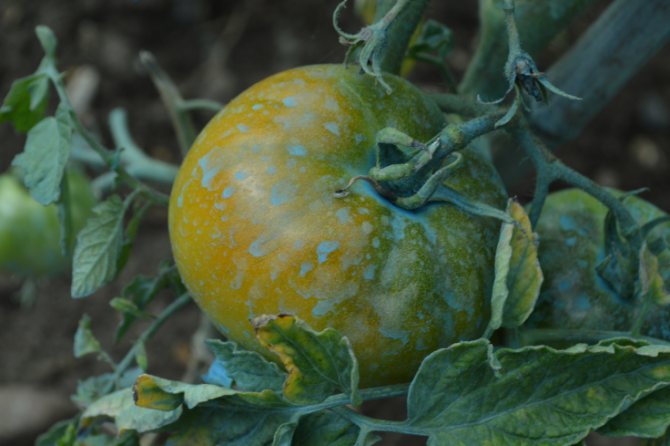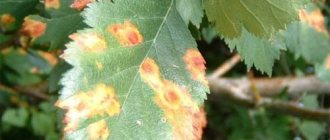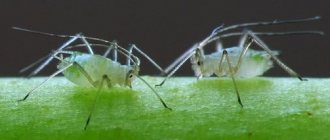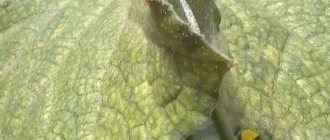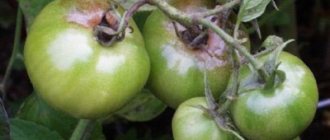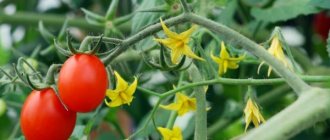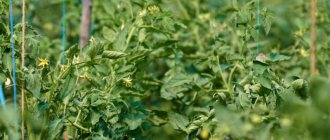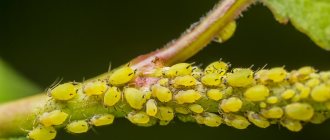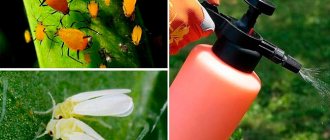Hello, Alexander is with you. Today we will talk about such an insidious disease of tomatoes as late blight, it is also brown rot. And her cunning lies in the fact that she can appear completely suddenly, affecting the entire crop. Phytophthora is translated from the Greek language - "plant" + "destroying, destroying, destructive."
In many publications, phytophthora is called a mushroom. In fact, this is not entirely true, late blight occupies an intermediate position between the huge kingdom of mushrooms and the kingdom of protozoa. It is for this reason that many chemicals called fungicides do not work. Nevertheless, it is possible and necessary to fight late blight, and, as practice shows, it is quite successful.
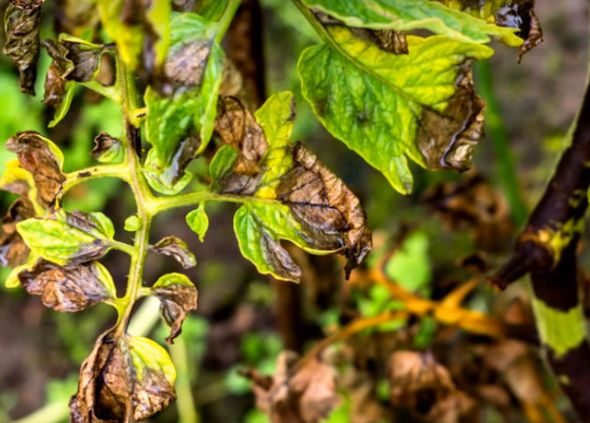
Today we will consider the causes of late blight on tomatoes, where it comes from and how to deal with it. I practically do not use chemicals on my site, so the methods of control will be extremely biologically safe both for tomatoes and for you.
What is late blight
Late blight is a pernicious disease caused by the rapid multiplication of fungal spores. Pathogens, getting on the plant, penetrate into its body and in the shortest possible time take possession of it completely. Phytophthora affects all parts of the tomato bush, not forgetting about the fruits.
reference
"Late blight" is translated as "destroying plant".
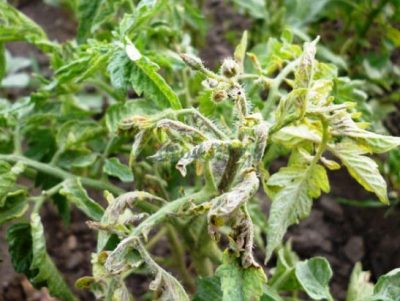

The disease manifests itself most strongly in regions with a humid climate, in rainy summers. The peak of the disease is July-August. In a drought, the development of phytophthora stops, but this only means that it has calmed down and is waiting for more comfortable conditions. With the onset of warm and humid weather, the disease begins to attack tomatoes with renewed vigor. Then there is practically no point in fighting it.
Pathogenic fungi live primarily in the soil. They get there through the remains of infected crops, diseased seeds, poor seedlings, non-sterile garden tools. The pathogen can also remain in the air for a long time.
The fungus multiplies with the help of spores, which have extraordinary endurance. In water, their colony grows many times faster. The longer the water drops remain in the axils of the stems, at the base of the leaves, in the sepals, the faster the spores will develop - the whole process takes about 5 hours.
There are many varieties of phytophthora inherent in different garden crops. The disease of nightshades, in particular tomatoes, is caused by a pathogen of a fungus called Phytophthora infestans.
reference
Scientists have identified a tendency to update the genetic structure of phytophthora. If earlier, back in the middle of the last century, the fungus was strongly dependent on temperature and humidity, today it has adapted to weather conditions. In addition, the new late blight has the ability to reproduce sexually. The population forms the so-called oospores that can overwinter in the ground.
How does the disease manifest
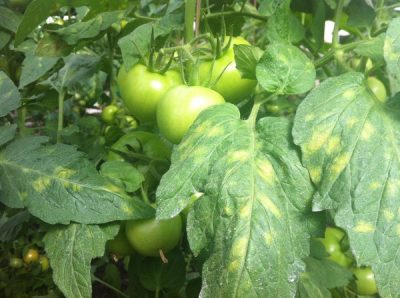

Heat is not the main criterion for the activation of the fungus. The trigger is the increased humidity in the greenhouse. As soon as conditions become comfortable, spores begin to actively replenish their colony. Starting from the lower leaves, the spores take over the entire plant.
All affected areas change color to brown and even black, are covered with mycelium. Inflorescences affected by late blight dry out and fall off, and after them the fruits are affected. First, a brown spot grows on the top of the fetus, and then painful foci cover the entire fetus. The peel becomes thinner, its structure deteriorates. The pulp rots, sour, smells bad. The infected bush completely loses its quality in a few days.
Important!
Greenhouse plants are usually less likely to suffer from disease. However, getting inside the greenhouse, the infection spreads with lightning speed. The incubation period of late blight disease lasts from 3 to 14 days. Therefore, in a greenhouse, plants can die in a few days.
Causes of the onset of the disease
Effective control of the fungus is possible when the reasons for its appearance in greenhouse beds are known. The main reasons include:
- the location of tomatoes next to crops, often affected by late blight (potatoes);
- thickened fit, poor ventilation;
- sudden changes in temperature during the day;
- rainy cloudy summer;
- excessive watering, dense soil, which leads to stagnant water;
- excess nitrogen;
- lime soil;
- lack of phosphorus, iodine and potassium in the soil.
Phytophthora - know the enemy by sight!


Tomato phytophthora refers to fungal diseases. It appears as irregular spots with pale green edges and a white moldy coating on the back of the leaf that appears in rainy weather.
The signs of late blight include the presence of infrequent or continuous stripes of dark brown color on the stems and leaf petioles. In the dry period, the affected areas dry out, with high humidity they rot.
In unfavorable weather, the invasion of late blight of tomatoes begins in June. Phytophthora multiplies exponentially at air humidity of 90% and a temperature of +20 degrees. She is especially fond of damp weather with sharp temperature changes, that is, when a cool night is followed by a warm, cloudy day.
Processing tomatoes from late blight
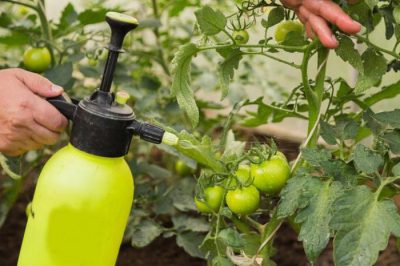

Protective measures in the fight against late blight must be taken even before its appearance and start with the seedling period of tomatoes. Before planting, the plants are sprayed with a 5% solution of Bordeaux liquid. This will help strengthen the plants and increase their disease resistance. For the first time, tomatoes are processed two days before transplanting seedlings. After 12 days, the treatment is carried out with Arcerid. For the third time, seedlings are treated with Fundazol. During the planting of young bushes, the drug Trichodermin is added to the hole.
The reasons for the development of late blight in tomatoes
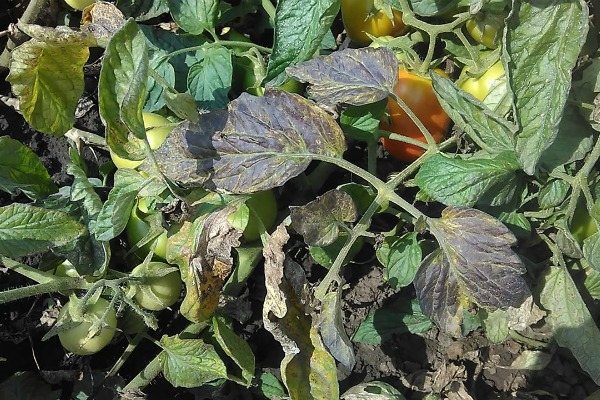

Before starting to disassemble the methods of dealing with a fungal disease, it is worthwhile to dwell on the causes of the disease. Among the main ones are the following:
- planting in the immediate vicinity of tomatoes and potatoes (the disease most often begins with the last plant);
- excessive planting density, there is no ventilation between plants;
- with an excessive accumulation of nitrogen in tomatoes, late blight may also occur (an excess of fertilizing);
- improper watering of the crop, too much moisture. Root irrigation is recommended, they are organized in such a way that water does not fall on the stem and foliage.
How to cultivate the land after a disease
Since the fungus accumulates in the soil, it is from it to start the fight against the infection. It is impossible to completely eradicate the fungus, however, you can significantly reduce the population of the fungus, drown it. This is done in three ways: chemical, biological and agrotechnical.
Proper agricultural technology works wonders: if you carefully monitor the plantings, observe crop rotation, remove plant residues in time, do not thicken the plantings, control the humidity and temperature of the greenhouse, prevent condensation, then late blight may not appear at all, or at least delay development.
Traditional remedies
There are many safe, but effective improvised means with which you can process (disinfect) the earth. Many experienced summer residents spill greenhouse soil with milk whey, boiling water, manganese solution and other solutions. The best ones include:
Whey solution
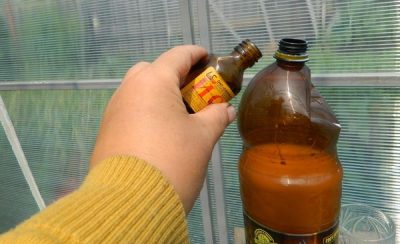

A liter of old kefir or whey is mixed with water and the soil is watered. For greater effect, iodine is added to the solution.
Straw mix
Ripe straw is poured with water, urea is added, insisted for several days. The area under the bushes is watered with the finished substrate.
Ash solution
500 grams of ash is poured with water, grated soap is added. All ingredients are thoroughly mixed until smooth. Then water the ground.
Biological methods
Biological agents are less aggressive than chemical agents, and therefore practically harmless, although they cannot completely cope with the disease. It is rational to use them in autumn tillage. The best fungicidal agents are: "Baktofit", "Trichodermin", "Planzir", "Alirin B", "Fitosporin", "Phytocide". They are added to the soil after digging. Re-processing is carried out in the spring.
Important!
The fungicide prepared according to the instructions should soak the ground to a depth of 10 centimeters.
Chemical fungicides
With a strong defeat by late blight, one cannot do without chemicals. They are very poisonous, and therefore they must be used only according to the instructions in a protective suit.
Attention!
Chemical treatment is stopped 21 days before harvesting. Otherwise, the poison will get on the fruit.


Greenhouse soil is disinfected with copper sulfate or treated with Bordeaux liquid, which contains vitriol. These funds saturate the soil with microelements, heal it. By the way, it is permissible to cultivate the land with Bordeaux liquid once every five years, while the plants themselves can be sprayed annually.
From specialized means used "Oxyhom", "Quadris", "Bravo", "Hom". These drugs are added to the hole during transplanting.
Note!
Please note Copper products should only be used in early spring, as copper can get into food.
Gardener Tips
Experienced gardeners recommend wrapping the roots of the seedlings with copper wire before planting. Some people simply pierce the stem of a tomato with it. How it works? Copper normalizes plant respiration, enhances oxidative processes.
As a result, the bushes stop growing and become more resistant to fungi. They pierce the stems only after they have become powerful. Never wrap the wire around the stem.
In addition, Bordeaux liquid takes pride of place among the remedies. It is a mixture of water, copper sulfate and lime. The solution is purchased at a store or prepared independently.
The drug is dangerous to humans, therefore, when using it, you must observe safety precautions - use protective clothing, goggles, and a respirator. Use Bordeaux mortar at least 2 weeks before harvest.
Important! Often tomato growers are advised to use a saline solution. You will need a bucket of water and a mug of table salt. The mixture will not only help get rid of the disease, but also protect the bushes.
Greenhouse processing
Spores spread with lightning speed inside the greenhouse, settling on the frame, walls. Therefore, in the fight against late blight, it is important to regularly process the greenhouse.
The processing of the greenhouse is carried out in the fall after harvesting and clearing the land from plant residues. Disinfection of a polycarbonate greenhouse involves fumigating with sulfur checkers. It also helps kill the spider mite larvae.
Attention!
During processing, it is necessary to make sure that the room is tight. All windows and doors must be closed. Disinfection is also necessary with a gas mask.
For metal greenhouses, wet disinfection is carried out. All parts of the structure are treated with bleach, including the soil itself. The solution is prepared as follows: 500 grams of lime is diluted in water. Insist for several hours, and then spray all surfaces.
Also, the frame and walls can be treated with a solution of copper sulfate, and the wooden sections of the structure can be treated with slaked lime. After disinfection, all walls and windows are washed with water with the addition of any cleaning agent.
In winter, it is necessary to regularly ventilate the greenhouse so that condensation does not accumulate in it and pathogenic microflora does not multiply.
Preventive measures
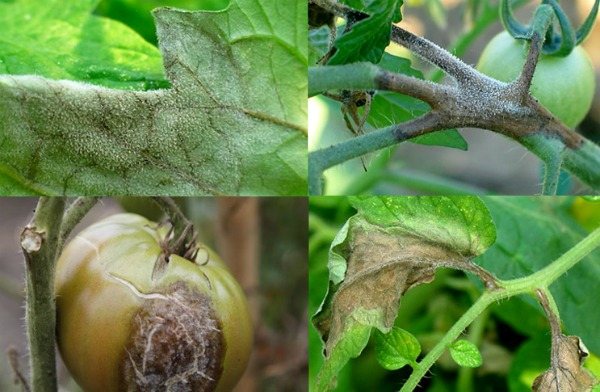

To reduce the appearance of late blight on the site, it is advisable to use the prevention of this disease:
- Correct fit. Tomatoes are not planted in the place where potatoes, peppers, eggplants used to grow, and these crops should not be nearby. An ideal place for tomato beds where cucumbers, beets, onions, etc. previously grew. Tomatoes are best planted in a new location every year.
- It is recommended to dilute the soil with a high lime content with peat (it is added to the planting hole), and after planting, a small amount of sand is poured next to the bushes.
- Tomatoes must be planted with respect to the distance between shrubs and do not allow thickening of the plantings.
- Watering should be root, water should not fall on foliage and tomatoes. It is important not to forget about loosening the soil layer next to shrubs.
- Mulching.
- It is recommended to plant white mustard, calendula, marigolds, garlic and onions near tomatoes.
- Timely carrying out pinching and breaking off unnecessary leaves.
- The introduction of potassium and phosphorus fertilizers, spraying with immunostimulating substances to enhance the immune system of the plant.
- Regular ventilation of the greenhouse.
- The introduction of nitrogen fertilizers in the first half of the growing season, then an excess of nitrogen can provoke the appearance of late blight.
Compliance with these simple rules will avoid contamination of tomatoes with a dangerous disease. Every gardener should remember that it is easier to prevent any ailment than to treat it later.
Spraying plants


In the fight against late blight, all parts of the bush must be carefully processed, so most of the products must be sprayed on the leaves and stems. The most effective specialized drugs are Ridomil Gold, Trichopol, Thanos and Revus. All of them form the thinnest film on the surface of the tops, which prevents the penetration of the fungus inside. They are not washed away by the rain. Spraying can be done 2-3 times per season.
For prevention purposes, tomatoes are watered with copper sulfate 7-10 after transplanting. Then the leaves are irrigated with potassium iodide diluted with water. In the interval, spraying with Epin is carried out. With a strong defeat by late blight, the preparations Alirin-B, Baikal, Gamair are suitable to help the summer resident.
Features of the fight against the disease


Experienced gardeners believe that it is completely impossible to get rid of this disease.
It is especially difficult to do this in a closed greenhouse space, in 2-3 days late blight, in favorable conditions, can destroy up to 80% of tomatoes.
To avoid disease and get a good harvest, protective measures must be taken to protect the plants.
Considering that fungal spores can be found on all surfaces of the structure, it is necessary:
- Carry out measures to decontaminate the walls of greenhouses and soil.
- Use tools designated only for greenhouse work.
- Monitor the air temperature, avoiding sudden changes.
- Provide proper watering and ventilation.
- Carry out preventive measures for the processing of tomatoes with special means.
Tomato planting care
Attentive and painstaking care of tomatoes will help to avoid the appearance of diseases, including phytophthora:
- Since the fungus remains active for 3-4 years, you should not place tomato beds in the same place for two years in a row.
- Before sowing, the seeds must be disinfected with a manganese solution and soaked in a growth stimulator. This will help grow healthy, robust, highly immune seedlings.
- Tomato bushes grow well on slightly acidic soils. If the soil is too limed, the pH level can be leveled by adding peat.
- Seedlings should be planted, observing the interval between the bushes up to 40 centimeters. In thickened plantings, a lot of moisture accumulates, which causes the spread of the fungus. The bed must be well ventilated.
- The temperature in the greenhouse should be no higher than 23 degrees, and the humidity should be 60-70%.
- Watering should be regular - rare, but abundant. Water stagnation and foliage moisture should not be allowed.
- Tall tomatoes need to be shaped into 1-2 stems, tied to a trellis so that they are well blown by the wind.
- To maintain the immunity of tomatoes, they must be regularly fed, sprayed with immunomodulators.
- It is important to carry out loosening in order to avoid the formation of an earth crust and compaction of the earth structure.
- In regions with an uneven climate and frequent rains, disease-resistant varieties are chosen.
Where does late blight come from: causes of the disease
Late blight of tomatoes occurs when a plant is damaged by an oomycete (mushroom-like organism) Phytophthora infestans. Infection occurs through spores that are scattered by the wind from diseased plant tissues to healthy ones.
This process becomes rapid under conditions of high humidity and moderate temperatures (15-22 ° C). Also, the disease often starts at high daytime temperatures (30-35 ° C), if the conditions are very humid, and the nighttime temperatures are moderate (15-22 ° C). Similar weather in our country often occurs at the end of July-August. This period is the peak of late blight disease.
It is known that the phytophthora pathogen does not live directly in the ground, but can winter in plant debris, including unharvested potato tubers. Tomato seeds can also be infected initially.
Late blight often "flies" on tomatoes from infected potato plantings, if they are located nearby (closer than 500 m). And if by this time the plantings are not protected by an appropriate fungicide, the weather is favorable for the development of the pathogen, there is a lot of droplet moisture on the leaf, then the rapid development of infection cannot be avoided.
Note!
In addition to tomatoes and potatoes, other nightshades are susceptible to late blight: pepper, eggplant, nightshade, petunia. Less commonly, grapes, strawberries, cucumbers are affected. The planting of these plants can also serve as a source of late blight infection.
Tomato processing rules


You can defeat an insidious enemy using various means, but they must be used correctly and in a timely manner. The processing of plants is approached responsibly, following the following rules:
- preparations are diluted according to the instructions;
- a windless cloudy dry day is chosen for processing;
- all work with chemicals is carried out early in the morning or in the evening;
- chemical agents are not used after the fruits have begun to ripen.
It is important to remember that the air humidity in a greenhouse is much higher than in an open field, and this is the best condition for the appearance of fungus. Therefore, the processing of plants in greenhouses is carried out more often.
Where can it come from?
When planting beautiful and healthy tomato seedlings in a greenhouse, you need to know that this does not guarantee a good harvest. For several years, a fungal infection has been living in the ground - late blight., she may not show herself in any way. Only under certain conditions in the greenhouse there is a reproduction of this type of fungus and the defeat of tomatoes.
It should also be borne in mind that fungal spores can be brought in with a tool, on clothes, with seedling soil, wind, etc. Late blight tends to change and mutate, which complicates the fight against this fungus.
The best folk remedies for phytophthora
Many summer residents are afraid to use chemicals for processing greenhouse tomatoes. Their fears are obvious - the poison can get on the fruits, and it will be unsafe to eat them. They mainly fight against pathogenic fungus in traditional ways. However, experts believe that phytophthora cannot completely defeat either garlic or yeast. But still, in fairness, it is worth saying that folk, which means safe for plants, means you can slow down the development of the disease and keep most of the crop intact.
Tinder fungus-based remedy
Another fungus, tinder fungus, will help to cope with an aggressive pathogen. After processing the tomato with the infusion of tinder fungus, the plants become stronger, immune-protected. Finding a beneficial mushroom is not difficult - it usually grows on old or dying trees. A dried specimen is suitable for the preparation of medicinal infusions.
Recipe
Finely chop 200 grams of product (caps) and pour two liters of boiling water. The mixture should be infused in a dark, warm place for 24-30 hours, until it cools completely. Then the infusion will be more concentrated. Then strain the solution and use for spraying tomatoes.
If the healing liquid gets on the fruits, then white spots will remain on them. This should not disturb the summer resident, since they can be easily washed off with water. Infusion based on tinder fungus can be used as a prophylaxis. In this case, the processing is carried out every 10 days. In case of damage by late blight, spraying should be carried out more carefully, special attention is paid to the affected plants. Treatment is carried out every two weeks.
Garlic treatment
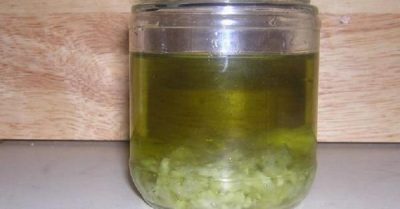

Garlic is considered the most dangerous enemy of late blight. On its basis, several medical recipes have been created for an insidious disease. Most are made from just two ingredients - garlic and water. But there are also more complicated prescription options. However, they all have one principle of action - through spraying, the smallest particles of garlic infusion quickly penetrate into the leaf and deliver phytoncides there, which suppress the vital activity of the fungus.
The best garlic mixtures for sprinkling tomatoes
- Chop 2 cups of garlic into gruel and pour three liters of cold water. Keep the resulting mixture in a dark place for 5-6 days. Then add more water to the concentrate at the rate of 0.5 liters of the mixture per 10 liters of water. For the sticking effect, add laundry soap to the solution, then spray.
- Mix 200 grams of chopped garlic with a pinch of mustard, red pepper, pour two liters of water and leave to infuse for a day. Then strain the mixture and dilute with water (10 liters). Spray with the composition every 14 days, starting immediately after planting the seedlings in the ground. The solution is effective against various types of insects.
- At the first symptoms, spray the bushes with a solution of 100 grams of garlic porridge and two liters of water.
- To prepare a useful substrate, mix chopped garlic cloves (100-120 grams) with potassium permanganate (5-10 grams) and a bucket of boiling water, and leave in a dark place for 2-3 days. Process the tomatoes with a ready-made solution several times a day until the late blight recedes.
Dairy products from late blight on tomatoes
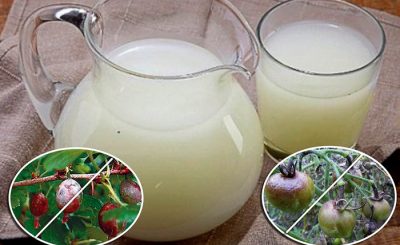

Between the main spraying with specialized fungicides, it will not be superfluous to process tomato bushes with solutions, the main ingredient of which is dairy and fermented milk products. It is known that lactic acid bacteria are capable of suppressing pathogens caused by late blight. The greatest result is shown by the treatment with milk whey. After the milk turns sour, whey is separated from it and diluted in water in a 1: 1 ratio. Treatment with the resulting solution is carried out daily, starting in July, at a time when late blight is just beginning to gain momentum.
There are many simple recipes based on dairy products and iodine. The latter has an antimicrobial effect, and therefore is considered one of the most formidable enemies of phytophthora.
The most common recipes
- Mix milk or kefir (1 liter) with 25 drops of iodine. As soon as the solution takes on a uniform shade, it can be used to spray the bushes.
- If there are no dairy products in the house, iodine can be diluted in plain water. This will require 10 milliliters of iodine and 10 liters of water. Spray twice with an interval of three days.
- Stir a liter of milk (low-fat) with 10 liters of water and add 20 drops of iodine. Spray.
- In 10 liters of water, dilute 2 liters of yogurt, add 100 grams of sugar and 15 drops of iodine. Process the bushes.
- In a bucket, mix 10 liters of water, a liter of whey, 40 drops of iodine and a spoonful of hydrogen peroxide. Carry out the processing of tomatoes, paying special attention to the underside of the leaves.
- Pour old kefir or yogurt with water and add a little sugar. Use the product as a preventive measure once a week.
How else to treat tomatoes for late blight
- soda - baking soda (1 teaspoon) is stirred in 5 liters of water, adding a little grated soap. Spray the plants once a week immediately after watering or rain;
- salt - the seedlings are sprayed with saline, after which a white bloom remains on the leaves, which will prevent the entry of bad fungi into the plants. To prepare the solution, you will need 250 grams of salt and 10 liters of water;
Note!
Salt solution serves only to prevent the development of phytophthora, since it acts only on the surface of the plant.


- vinegar - 100 milliliters of table vinegar is diluted in a bucket of water and completely sprayed with tomatoes. Such treatment will give a certain effect if you alternate it with chemical agents;
- toothpaste - it is diluted in water and irrigated with tomato bushes. The toothpaste contains many components that have a bactericidal effect. Thus, spraying with such a solution will help to curb the growth of pathogenic fungi;
- hot water - planting is spilled with boiling water, so as not to damage the tops. Since the fungus dies at temperatures above +30 degrees, ordinary hot watering will be an excellent, and most importantly, a cheap and safe way to fight the disease;
- yeast - 100 grams of dry product is diluted in water, and the resulting mixture is sprayed with plantings. The use of the drug is effective when the first signs of the disease appear;
- hydrogen peroxide - the drug is diluted in water and vegetable beds are treated once a week, especially paying attention to the lower leaves on tomato bushes. The oxidizing action of peroxide will destroy the pathogenic fungus;
- brilliant green - 40 drops of antiseptic are placed in a bucket of water and arrange treatment. Can be used for prophylaxis and directly to destroy the emerging fungus;
- boric acid - a drug diluted in water and hit on plants by spraying, acts as an antiseptic and causes the death of the pathogen;
Advice!
Alternate the use of boric acid, brilliant green, manganese and iodine - this will give the most effective result.
- copper sulfate is the most effective way to fight fungal diseases. The product is mixed with water and the planting is shed. Regular processing gives good results.
By the way!
You can protect tomatoes from late blight using ordinary copper wire. The fungus is known to be intolerant of copper. Just wrap the wire around the root collar, and bend the ends into the ground or stick into the stem. Copper will strengthen the immunity of plants and will keep the insidious fungus out of the tomato beds.
Tomato phytophthora - signs of plant infection
The disease late blight is caused by the simplest fungus, which is invisible to the human eye due to its microscopic size - Phytophthora infestans.The smallest mushroom has an incredible ability to multiply quickly. In a short time, planting greenhouse tomatoes may be infected with late blight, and hopes for a harvest will rapidly diminish.


Phytophthora can affect both mature and green fruits.
The disease usually develops on the lower leaves, which are covered with brown spots, and fungal spores develop on them in the form of white thin fluff. Then the infection takes over the main stems, making it impossible to feed all parts of the plant with water.
Last of all, late blight affects the fruits of tomatoes. Brown stains appear on them, the fruits are mummified and rotted. The disease develops even on unripe tomato fruits.
Attention! Intact tomatoes collected from a diseased plant cannot be stored - late blight can appear on these fruits at any time.
Usually, an outbreak of late blight in a greenhouse coincides with the onset of cold nights after a hot day. This temperature difference is typical for the second half of summer, just during the ripening of tomato fruits.


Tomato flowering affected by late blight
The defeat of tomato plants by late blight can be dry (when all parts of the plant simply dry out) and wet (characterized by the development of rot). Rot on plants develops in inclement rainy weather.
Late blight resistant varieties
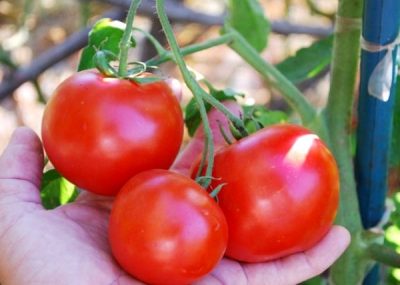

Late blight can affect absolutely any variety of tomato. However, in the last decade, tomato varieties have emerged, most of them hybrid, that can successfully resist the multiplication of the pathogen. It is recommended to choose early ripe tomato varieties for planting so that the crop has time to ripen before the onset of the enemy fungus. The most resistant to late blight varieties:
- It is gratifying.
- Budenovka.
- Grotto.
- Kostroma.
- Solar.
- Dubrava.
- Pink dwarf.
- Parterre.
- Snezhana.
- Lark F1.
- De Barao.
- Berry.
- Cameo and others. Oak.
- Perseus.
- Gardener.
- Orange miracle.
- Carrot.
- Juggler F1.
- De Barao Black.
- Cardinal.
- Carlson.
Can I take seeds from diseased tomatoes?
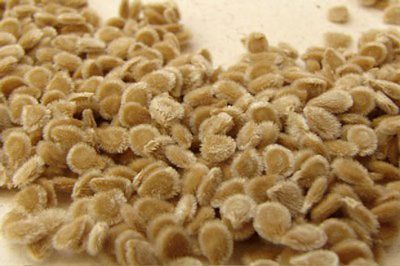

Naturally, seeds harvested from diseased fruits will also be infected. However, pre-sowing soaking of seed in hot water (above 50 degrees) can destroy the fungus. Thus, you can get quite healthy seeds, suitable for planting and growing strong seedlings.
By the way: it is better to use seeds 2-3 years old. During this time, all pathogenic microflora will have time to die.
Harvesting and storage
On diseased bushes, outwardly healthy green tomatoes without brown spots can be preserved. They need to be collected and immersed in warm water (60 ° C) for 15 seconds. Before sending the fruits for ripening, they are thoroughly wiped off.
They save the tomato harvest with the help of blanks. Both red and green fruits can be used. During heat treatment, the spores of the fungus die. There are preparations made from fruits plucked from diseased bushes, it is not dangerous.


Prevention of late blight in the greenhouse
As you can understand, it is practically useless to fight a pathogenic fungus, since it multiplies so quickly that not a single even the most powerful chemical agent can catch it. It is possible to partially save plantings, to delay the appearance of phytophthora in the greenhouse, using the correct agrotechnical techniques. Basic rules of prevention:
- Observance of crop rotation is necessary. You can not plant tomatoes in the former beds with potatoes, peppers, eggplants. A crop cannot be grown in one place for two years in a row.
- The area for tomatoes should be sunny, with low groundwater, not swampy.
- You should not thicken the planting, and at the same time create comfortable conditions for the pathogen.
- Tomatoes should be watered at the root, leaving the foliage dry.
- Keep the humidity and temperature in the greenhouse under control at all times.Arrange regular ventilation.
- If there is a lot of lime in the soil, then it is necessary to add peat to it, and sprinkle it with sand under the bush.
- It is worth choosing hybrid early maturing varieties - they are least susceptible to damage by late blight.
- To reduce the number of watering, you can resort to mulching the land.
- It is necessary to form the bushes correctly (preferably 1-2 stems), remove stepchildren in a timely manner, remove the lower leaves.
- It is wise to use top dressing: at the beginning of the growing season, tomatoes are fed with nitrogen, and from the middle of summer, phosphorus-potassium compounds are introduced.
- It is appropriate to plant mustard, calendula, marigolds, onions and garlic around the beds with tomatoes - these plants will scare away pests.
- Only healthy, strong, properly developing seedlings are able to withstand the disease. Therefore, in seedlings, it is necessary to increase immunity and vitality with the help of immunomodulators.
Only the constant attention and hard work of a gardener can help avoid the appearance of diseases on tomatoes. Compliance with preventive measures of protection will bring results - a rich and tasty tomato harvest.
Reasons for the appearance
There are several reasons for the occurrence of late blight in the greenhouse, the main one is excess moisture, it appears:
- With poor or no ventilation.
- With a small distance between tomato bushes.
- If the rules of crop rotation are not followed.
- With frequent or improper watering.
- Under the influence of the fog.
- The reproduction of spores of the fungus also provokes a sharp change in temperature, a warm day - a cool night.
One of the reasons for the appearance of late blight in the greenhouse is excessive nitrogen feeding.
Important! To avoid late blight infection, it is forbidden to plant solanaceous plants, especially potatoes, near the greenhouse with tomatoes.

